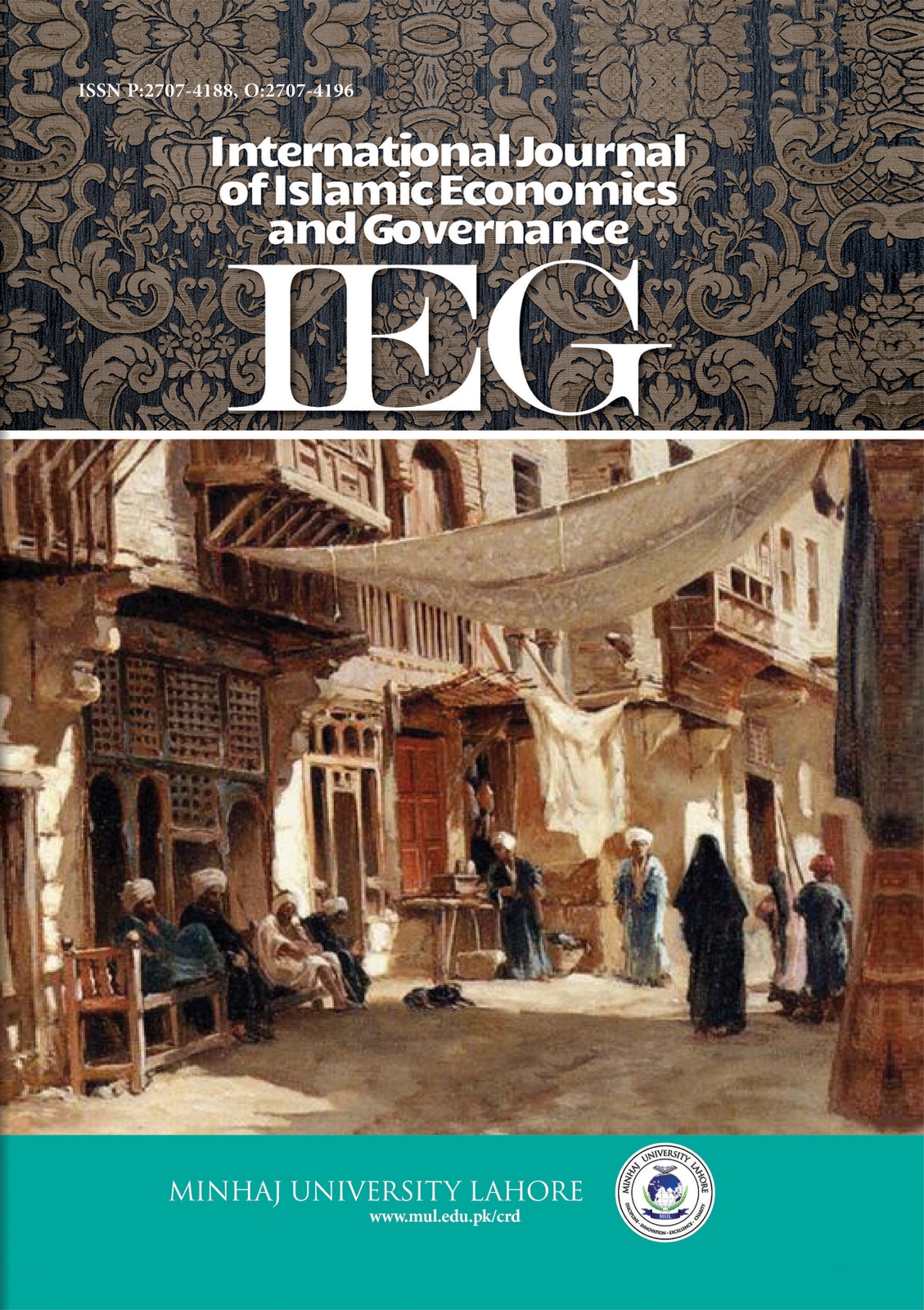Creation of Islamic Brand Equity: A Study of Malaysia
DOI:
https://doi.org/10.58932/MULD0048Keywords:
Islamic Branding, Islamic Brand Knowledge, ICSR, Religiosity, Brand ResonanceAbstract
The study explores the relationship between Islamic Branding and Brand Resonance of an Islamic Brand. This study empirically examines the influence of Islamic Branding Antecedents, i.e., Religiosity, Islamic Brand Knowledge, and Islamic Corporate Social Responsibility (ICSR) on Islamic Branding and its subsequent impact on the Islamic Brand Resonance. The research framework is based on the Customer-Based Brand Equity (C.B.B.E) pyramid and the Theory of Self-Congruity. The empirical study is conducted on the Muslim consumers in Malaysia. Survey research was conducted on a sample of 326 Muslim consumers from the cities of Kuala Lumpur, George Town, and Johor Baru. The results reveal a significant influence of Islamic Branding on the Brand Resonance among Muslim consumers in Malaysia. Furthermore, Religiosity, Brand Knowledge, and ICSR positively influence the perceptions of Malaysian Muslim consumers regarding Islamic Branding. Currently, research in the area of Islamic Branding is limited.
© 2025 The Author(s). Licensed under CC BY-NC 4.0.
References
Abuabdin, A. A., & Junaidu, U. (2024). Islamic Ethics in Business Development: Principles and Frameworks for Entrepreneurial Success. International Journal of Islamic Economics and Governance, 5(2), 63-74.
Ahmadova, E., & Aliyev, K. (2019). Determinants of attitudes towards Halal products. Empirical evidence from Azerbaijan. Journal of Islamic Marketing. https://doi.org/10.1108/JIMA-04-2019-0068
Ahmad, S., Qamar, A. J., Bhatti, M. A. A., & Bashir, U. (2023). Integrating Islamic Ethics with Modern Governance: A Comprehensive Framework for Accountability Across Religious, Social, and Economic Dimensions. Al-Irfan, 8(15), 51-79.
Alserhan, B. A. (2010). On Islamic branding: brands as good deeds. Journal of Islamic Marketing, 1(2), 101–106. https://doi.org/10.1108/17590831011055842
Ambedkar, A. R., Murugesan, P., & Thamaraiselvan, N. (2018). Modeling brand resonance score (BRS) – an application in financial services. Journal of Modelling in Management, 13(1), 119–136. https://doi.org/10.1108/JM2-10-2016-0088
Akbar, A., Ahmad, S., Nadim, M., Bhatti, M. A. A., & Khan, H. (2024). Affect of Hrm on Employee Motivation Towards Green Creativity and Initiatives. Center for Management Science Research, 2(3), 197-216.
Badrinarayanan, V., Suh, T., & Kim, K.-M. (2016). Brand resonance in franchising relationships: A franchisee-based perspective. Journal of Business Research, 69(10), 3943–3950. https://doi.org/10.1016/j.jbusres.2016.06.005
Buil, I., Martínez, E., & de Chernatony, L. (2013). The influence of brand equity on consumer responses. Journal of Consumer Marketing, 30(1), 62–74. https://doi.org/10.1108/07363761311290849
Bhatti, M. B. A., & Khan, M. K. (2024). Implications of Project Managers’ Competencies on Project Success Moderating effect of Project Risk Management: A case of IT Sector in Lahore. Pakistan Journal of Multidisciplinary Research, 5(1), 66-85.
Bukhari, S. A. A., Hashim, F., & Amran, A. B. (2021). Determinants and outcome of Islamic corporate social responsibility (ICSR) adoption in Islamic banking industry of Pakistan. Journal of Islamic Marketing, 12(4), 730-762.
Bukhari, S. N. Z., & Isa, S. M. (2020). Islamic branding: insights from a conceptual perspective. Journal of Islamic Marketing, 11(6), 1743-1760.
Bukhari, S. N. Z., Isa, S. M., & Yen Nee, G. (2021). Halal vaccination purchase intention: A comparative study between Muslim consumers in Malaysia and Pakistan. Journal of Islamic Marketing, 12(4), 670-689.
Bukhari, S. N. Z., & Bukhari, S. A. A. (2025). Customer-Based Islamic Brand Equity (CBIBE) Pyramid. Journal of Climate and Community Development, 4(1), 78-90.
Bhatti, M. A. A., & Nazir, M. U. (2024). The Impact of Project Process Management on Sustainable Project Success in the Construction Sector: The Moderating Role of Risk Management Practices. Bulletin of Business and Economics (BBE), 13(2), 1065-1072.
Butt, M. M., Rose, S., Wilkins, S., & Ul Haq, J. (2017). MNCs and religious influences in global markets: Drivers of consumer-based halal brand equity. International Marketing Review, 34(6), 885–908. https://doi.org/10.1108/IMR-12-2015-0277
Bano, S., Afzal, H., ul Hassan, R., & Bashir, U. Well-Being Dimensions and Environmental Protection: The Role of Health, Life Satisfaction, and Financial Satisfaction Waqas Shair1.
Çifci, S., Ekinci, Y., Whyatt, G., Japutra, A., Molinillo, S., & Siala, H. (2016). A cross validation of Consumer-Based Brand Equity models: Driving customer equity in retail brands. Journal of Business Research, 69(9), 3740–3747. https://doi.org/10.1016/j.jbusres.2015.12.066
Cobb-Walgren, C. J., Ruble, C. A., & Donthu, N. (1995). Brand equity, brand preference, and purchase intent. Journal of Advertising, 24(3), 25–40. https://doi.org/10.1080/00913367.1995.10673481
Ding, C. G., & Tseng, T. H. (2015). On the relationships among brand experience, hedonic emotions, and brand equity. European Journal of Marketing, 49(7–8), 994–1015. https://doi.org/10.1108/EJM-04-2013-0200
Dwivedi, A., Johnson, L. W., Wilkie, D. C., & Araujo-Gil, D. (2018). Consumer emotional brand attachment with social media brands and social media brand equity. European Journal of Marketing, 53(6), 1176–1204. https://doi.org/https://doi.org/10.1108/EJM-09-2016-0511
EL KHAMLICHI, A. (2024). Islamic and Socially Responsible Indices: A Case Study of Dow Jones Islamic Market Sustainability Index. International Journal of Islamic Economics and Governance, 5(2), 75-91.
France, C., Merrilees, B., & Miller, D. (2015). Customer brand co-creation: a conceptual model. Marketing Intelligence & Planning, 33(6), 848–864.
Fu, X., Kang, J., Hahm, J. J., & Wiitala, J. (2020). Investigating the consequences of theme park experience through the lenses of self-congruity and flow. International Journal of Contemporary Hospitality Management. https://doi.org/10.1108/IJCHM-06-2019-0522
Geisser, S. (1974). A predictive approach to the random effect model. Biometrika, 61(1), 101–107.
Hair, J. F., Risher, J. J., Sarstedt, M., & Ringle, C. M. (2019). When to use and how to report the results of PLS-SEM. European Business Review, 31(1), 2–24. https://doi.org/10.1108/EBR-11-2018-0203
Ghaffar, M. A., Shair, W., Afzal, H., ul Hassan, R., & Bashir, U. (2024). Income and Income Aspiration: Exploring the Impact on Life and Financial Satisfaction. Journal of Economic Impact, 6(3), 257-263.
Ibrahim, A., Suleiman, A. H., & Mohammed-Gani, S. (2024). Estimating Demand and Supply of Halal Consumables in Nigeria: Evidence from Selected Shop-rites and Supermarkets in Abuja, Nigeria. International Journal of Islamic Economics and Governance, 5(1), 21-34.
Japutra, A., Ekinci, Y., & Simkin, L. (2019). Self-congruence, brand attachment and compulsive buying. Journal of Business Research, 99, 456–463. https://doi.org/10.1016/j.jbusres.2017.08.024
Justo, R., & Cruz, C. (2009). Mecca/Cola: Message in a bottle. Journal of Research in Marketing and Entrepreneurship, 10(1), 40–56. https://doi.org/10.1108/01443571010996226
Jawad, S., Naveed, H., & Akram, M. B. (2020). Academic Performance of Enrolled Students in the University of Lahore, Pakistan. Quest Journal of Management and Social Sciences, 2(2), 357-365.
Keller, K. L. (1993). Conceptualizing, Measuring and Managing Customer-Based Equity. Journal of Marketing, 57(1), 1–22. https://doi.org/10.2307/1252054
Bhatti, M. B. A., & Durrani, M. K. (2024). The effect of project managers’ competencies on project success with mediating role of project stakeholders’ engagement: A case of IT sector. Journal of Management Info, 11(1), 51-73.
Keller, K. L. (2009). Building strong brands in a modern marketing communications environment. Journal of Marketing Communications, 15(2–3), 139–155. https://doi.org/10.1080/13527260902757530
Koleva, P. (2020). Towards the Development of an Empirical Model for Islamic Corporate Social Responsibility : Evidence from the Middle East. Journal of Business Ethics. https://doi.org/10.1007/s10551-020-04465-w
Latif, I. A., Mohamed, Z., Sharifuddin, J., Abdullah, A. M., & Ismail, M. M. (2014). A Comparative Analysis of Global Halal Certification Requirements A Comparative Analysis of Global Halal. Journal of Food Products Marketing, 20(1), 85–101.
Liu, R. L., & Minton, E. A. (2018). Faith-filled brands: The interplay of religious branding and brand engagement in the self-concept. Journal of Retailing and Consumer Services, 44(June), 305–314. https://doi.org/10.1016/j.jretconser.2018.07.022
Maulan, S., Omar, N. A., & Ahmad, M. (2016). Measuring halal brand association (HalBA) for Islamic banks. Journal of Islamic Marketing, 7(3), 331–354. https://doi.org/10.1108/JIMA-09-2014-0058
Moura, L. R. C., Ferreira, P. R., Oliveira, A. D. de, & Cunha, N. R. da S. (2019). Test and validity of the Brand Resonance Model’s. Revista Gestão & Tecnologia, 19(1), 4–24. https://doi.org/10.20397/2177-6652/2019.v19i1.1466
Richards, I., Foster, D., & Morgan, R. (1998). Brand Knowledge Management: Growing Brand Equity. Journal of Knowledge Management, 2(1), 47–54. https://doi.org/10.1108/13673279810800762
Ringle, C. M., Wende, S., & Becker, J.-M. (2024). SmartPLS 4. Bönningstedt: SmartPLS. Retrieved from https://www.smartpls.com
Rafaqat, M. ., Azad, F. ., Ahmad, S. ., Aijaz, K. ., Ikram, S. H. ., Bashir, U. ., Bhatti, M. A. A. ., & Saeed, S. . (2024). Impact of Governance and Strategy Performance on Employer Branding. Research Journal for Societal Issues, 6(2), 852–867.
Rinka, X. X., & Pratt, S. (2018). Social media influencers as endorsers to promote travel destinations: an application of self-congruence theory to the Chinese Generation Y. Journal of Travel and Tourism Marketing, 35(7), 958–972. https://doi.org/10.1080/10548408.2018.1468851
Stone, M. (1974). Cross-Validation and Multinomial Prediction. Biometrika Trust, 61(3), 509–515.
Suhartanto, D., Gan, C., Sarah, I. S., & Setiawan, S. (2019). Loyalty towards Islamic banking: service quality, emotional or religious driven? Journal of Islamic Marketing, 11(1), 66–80. https://doi.org/10.1108/JIMA-01-2018-0007
Surya, E. D., & Saragih, M. G. (2019). Emotional Marketing To Purchase Decisions Halal Food In Medan City With Brand Awareness As Variable Intervening. Journal of International Conference Proceedings, 44–52. https://doi.org/10.5281/zenodo.1477753
Thomson, R., & Dinar, S. (2019). State of the global Islamic economy report 2019/20. Dubai International Financial Centre.
Tieman, M., Vorst, J. G. A. J. van der, & Ghazali, M. C. (2012). Principles in halal supply chain management. Journal of Islamic Marketing, 3(3), 217–243.
Usman, H., Tjiptoherijanto, P., Balqiah, T. E., & Agung, I. G. N. (2017). The role of religious norms, trust, importance of attributes and information sources in the relationship between religiosity and selection of the Islamic bank. Journal of Islamic Marketing, 8(2), 158–186. https://doi.org/10.1108/JIMA-01-2015-0004
Yusof, M., & Jusoh, W. (2014). Islamic Branding: The Understanding and Perception. Procedia - Social and Behavioral Sciences, 130, 179–185. https://doi.org/10.1016/j.sbspro.2014.04.022
Zafar, M. B., & Sulaiman, A. A. (2019). Corporate social responsibility and Islamic banks: a systematic literature review. Management Review Quarterly, 69, 159-206.
Zaman, R., Roudaki, J., & Nadeem, M. (2017). Religiosity and Corporate Social Responsibility Practices : Evidence from an Emerging Economy. Social Responsibility Journal, 14(2), 368–395.









